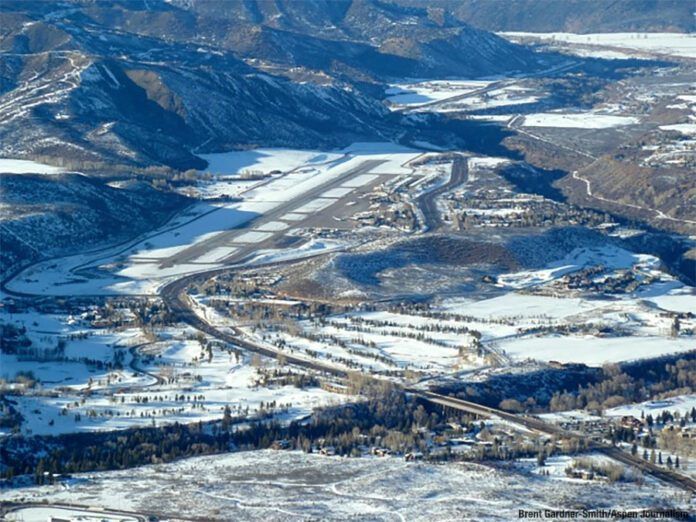Experienced pilots in Aspen have joined a task force to bring down the accident rate at the notorious local airport. Pitkin County commissioners approved formation of the task force, which is made up of 12 pilots who are familiar with the airport. There have been 40 serious general aviation accidents at Aspen in the last 40 years but none involving airliners. The airport is at 7800 feet, has a sloping runway surrounded by towering mountains and is subject to rapidly changing weather. Task force Chair Barry Vaughan said the group will make recommendations to county officials and won’t have the authority to make any rules or changes itself.
“It’s a real opportunity for the local pilot community to help in airport affairs,” said Vaughan. “Airport politics are convoluted and complex, and the pilot community, often perhaps at least from one perspective, isn’t heard much.” Among those on the task force are FlightAware founder Daniel Baker and ForeFlight creator Tyson Weihs. Others include pilots and aviation industry professionals with varied backgrounds and experience. There have been four serious accidents at the airport in the last year, including two runway excursions by private jets. While no one was killed, both planes were totaled and the accidents caused more than $500,000 in damage to airport property.




































Many are the takeoffs, approaches and landings along with an aborted takeoff in a snow storm and one hair raising go around I have witnessed at Aspen with my heart in my mouth, all while waiting for take off minimums to go up to our company standards. I applaud any effort to corral accidents at ASE, but in my humble opinion the accident rate will remain what it is till folks start being disciplined in their operations. In plain english, it boils down to basic operational potty training.
I agree. All pilots have to do is follow the limitations listed in the performance charts. The accidents that I am familiar with were the result of the crew doing something the airplane was not designed to do, exceeding limitations.
“All pilots have to do is follow the limitations listed in the performance charts.”
All well and good, and 100% accurate, but a lot of pilots don’t fully appreciate how much their aircraft performance changes in conditions outside of what they usually fly in.
Perhaps what might help pilots recognize that something is different is to also calculate what their margins are after doing the performance calculations. For example, if the performance data says they’ll use 800 feet to take off, on a 5000 foot runway you have a margin of 4200 feet. But on a 2500 foot runway, you now only have a margin of 1700 feet. Both are still doable, but it illustrates the difference between them.
And that is where the training received to fly those transport/jets comes into play. At one company the chief pilot would spend an entire day in recurrent going over all the performance charts for the various items required to be taken into account that are not covered with normal category planes. How many pt91 jet pilots fully understand how to calculate climb gradients and how the FAA certifies jets to meet those limits. There are a lot more to performance numbers with transport planes then just takeoff distance!
Uh, Matt, let’s not start comparing pt91 vs pt 135 pilot levels of understanding. We’ve seen some pretty horrible pt 135 crashes in the past few year.
If the ACFT. is calculated to be at MGTW. and the RWY is reported to be contaminated with 1/4 inch slush, are you sure the figures are correct? Most likely ballpark numbers. One fart from one engine may bring a very bad day. You just can’t teach common sense.
Flying transport category planes have much more performance info in the POH/AFM than normal category planes do. Any transport/jets certified after 1995 have performance information numbers than you refer to. Planes certified prior, at least Cessna Citations have that data but it is labeled as advisory. Not advisable to ignore that info. Since trying to figure out numbers using the POH/AFM charts and graphs is a pain in the behind, using laptop/IPad based programs/apps makes getting these performance numbers so much easier.
I wonder how many accidents are the result of crews, when asked to fly in bad weather, being unwilling or unable to tell the client “no”? Especially if that client is the one who signs their paycheck? Some, many, or none? The NTSB reports don’t always record external pressures.
I’m reminded of helicopter ambulances with a poor track record in bad weather. As I recall, one result is that the helicopter crews are now not given any information about the patient’s condition, just the location and time for the pickup. That way they can be somewhat more dispassionate about making the go/no-go decision.
The trick would be coming up with a way to remove the external pressure from the crews’ decision-making process. It shouldn’t matter how important the VIP is, or how tight their schedule, or how critical the meeting… but it sometimes does.
And, more importantly, removing any negatives for choosing to not go. For if one crew does abort for safety while another crew ‘safely’ gets in, who do you think the client will choose the next time?
This scenario is exactly what preceded the worst pt135 accident when a Gulfstream crashed into the mountainside at Aspen, attempting a circle maneuver after dark. Used to see the memorial wreath that someone put on that mountainside as I was doing the visual approach inbound. As someone who has been there several times in different planes, I have no problem telling the airplane owners or pax that we can’t go there due to weather, or lack of daylight. Fortunately the companies I flew for had strict limits for operating there that were much higher than the approach or departure procedures allow.
One serious accident a year at a mountain airport is not too bad.